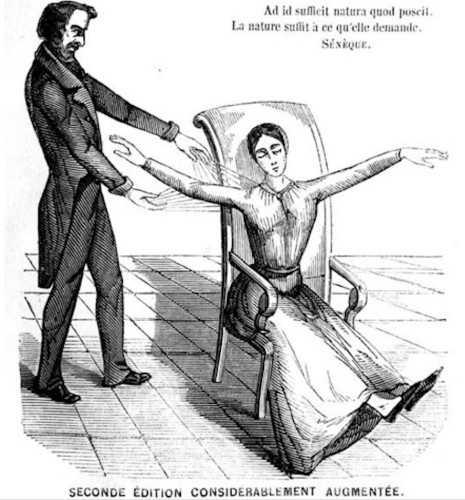
 The illustration in the introduction of the book L'art de magnétiser, ou Le magnétisme animal considéré sous le point de vue théorique, pratique et thérapeutique, by Charles Lafontaine, 1852.
The illustration in the introduction of the book L'art de magnétiser, ou Le magnétisme animal considéré sous le point de vue théorique, pratique et thérapeutique, by Charles Lafontaine, 1852.
Historically, the alternative medical notion of energy is closely intertwined with "esoteric" views that emerged in the late nineteenth century. However, there is no single agreed upon definition of subtle energies among practitioners, which makes it a fuzzy term that is open to a wide range of interpretations.
Subtle energies generally refer to agents that are claimed to work “in between” the physical and mental or spiritual levels of reality. Not perceivable by the five senses, these ethereal agents are thought to influence the body by means of ritual and other techniques. Practitioners assume the existence of hidden human potentials and view subtle energies as a resource for vitalizing, healing, or perfecting the individual self. These healing powers supposedly cannot be explained in terms of bio-medical or psychological theories. Furthermore, discourses surrounding subtle energies are not limited to therapeutic pursuits, but are also applied to bring about spiritual and social change.
A number of non-Western notions are subsumed under subtle energies. These include, for example, the Polynesian concept of mana (denoting supernatural powers), the Sanskrit words kuṇḍalinī (also known as the "serpent power" and often compared to Sigmund Freud’s idea of libido) and prāṇa ("breath" or "vitality"), as well as the Chinese medical concept of qì ("breath" or "vital energy").
Other terms closely associated with subtle energies include the ether theory, Franz Mesmer’s fluidum, Wilhelm Reich’s Orgone, "vibrations" that supposedly communicate the power of the mind over the body and material reality, and the "universal life energy" often invoked in energy healing. Finally, we can refer to "earth energies" within the Earth Mysteries movement.
Advocates of the idea take an ambivalent position towards the authority of science. On the one hand, scientific theories (e. g., ether, electrodynamics, quantum physics, etc.) have served as the reference point for notions of hidden powers, thus endowing them with an aura of credibility and prestige. On the other hand, advocates often claim access to ancient or exotic knowledge that is superior to contemporary Western-style science. The term "subtle energies" was strongly promoted as a general category in the late 1970s by Stanford physicist William A. Tiller (1929–2022). Tiller believed that current physical models are insufficient and proposed that "subtle energies" are at work in the form of "life force", non-physical healing agents, as well as phenomena such as telepathy. However, it should be noted that "subtle energies" is primarily a qualitative concept that indicates subjective perceptions and lived experiences that may occur within particular therapeutic or religious frameworks. This means that there are no recognized physical models that measure and compare quantities of subtle energy.
Despite their rejection in academia, notions of life force and ethereal energies became crucial elements in the alternative religious and therapeutic discourse of the late nineteenth century. The broader cultural context of scientification, colonialism, Oriental and Religious Studies, and anti-modernist reactions provided fertile ground for new religious-therapeutic ideas of energy. The enthusiastic as well as critical engagement with science became a hallmark of "occult" or "esoteric" literature and practices, which intentionally blurred and transgressed the established boundaries of science. Major movements that contributed to religious-therapeutic concepts of energy around 1900 were the Theosophical Society, modern yoga, and the Japanese reception of North American occultism. The theme of (subtle) energy was central to the American Human Potential Movement of the 1960s and the globalizing field of complementary and alternative medicine (CAM) from the 1970s onwards.
Today, subtle energies can be regarded as one of the most enduring concepts of modern esoteric discourse. This idea not only influenced alternative therapies and spiritual self-cultivation practices. It also had a profound although little recognized impact on music, visual arts, and cinematography as well as neo-pagan, ecological and political movements. A most illustrative example of the latter is the Chinese qìgōng movement that emerged in mainland China as "qìgōng therapy" during the 1950s and experienced a veritable boom in the 1980s and 90s. Qìgōng refers to practices that aim at self-perfection by transforming and cultivating the flows of qì. Millions of Chinese have joined qìgōng groups, which were often headed by charismatic leaders and gradually turned into a significant social and political force in China and beyond.
What makes the discourse on subtle energies controversial is its implicit critique of scientific and bio-medical materialism. It questions the reduction of life to physico-chemical principles and the tendency of over-specialization in the medical professions. Most crucially, the concept of subtle energies stands out for supporting the view that there are relatively simple methods to access hidden potentials as a means for healing and transformation.
Read more in the dictionary : Yoga
Read the paper in French : Énergies subtiles
References :
David A. Palmer, Qigong Fever: Body, Science and Utopia in China, London: C. Hurst & Co, 2007.
Julian Strube, Marleen Thaler, and Dominic Zoehrer, Subtle Energies in Therapy, Spirituality, Arts, and Politics. 1800–Present, Brill: Numen Book Series, eds. 2024. (In preparation.)
To quote this paper : Dominic Zoehrer, “Subtle Energies”, in Hervé Guillemain (ed.), DicoPolHiS, Le Mans Université, 2024.